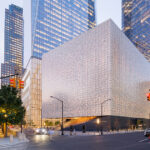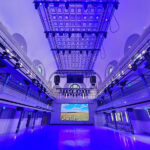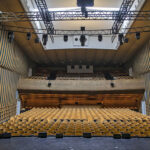Video Content Enhances Upscale Atmosphere Aboard Anthem of the Seas
Anthem of the Seas joins Quantum on the world’s high seas, as Royal Caribbean International (RCI) completes the second of its three ultra-technological cruise ship wonders known as “Smart Ships” (See “Smart Sailing,” PLSN, June 2015, page 46). Once again Christopher Vlassopulos, superintendent of Stage, Lighting and Video for RCI, designed and coordinated specification for all the entertainment equipment in the ship’s public spaces. With an eye to duplicate the success of Quantum, Vlassopulos called upon the same team of vendors. As a sister-ship to Quantum of the Seas, Anthem of the Seas features the same lighting and video package template. “The ships mirror each other” in terms of entertainment lighting, says Vlassopulos. “There was actually one exception, and that was in Two70, where we took out some non-Elation ground row and ceiling row lighting fixtures and replaced them with Elation ELAR Quad Bars, which are brighter than the previous fixtures, and less expensive.”
As a sister-ship to Quantum of the Seas, Anthem of the Seas features the same lighting and video package template. “The ships mirror each other” in terms of entertainment lighting, says Vlassopulos. “There was actually one exception, and that was in Two70, where we took out some non-Elation ground row and ceiling row lighting fixtures and replaced them with Elation ELAR Quad Bars, which are brighter than the previous fixtures, and less expensive.”
For Anthem, Vlassopulos again teamed with Benjamin Couling of Tristwell Solutions, the company responsible for installation and commissioning Quantum, and Hamburg, Germany-based Amptown System Company (ASC) once again oversaw the integration and interconnectedness of the media and entertainment technology, as they did on Quantum.
For more than 25 years, ASC has been known in Germany and beyond as an independent full-service supplier of top-quality media system solutions. Execution and technical detail planning was carried out by their marine division engineering team in close cooperation with RCI.
 Same Place, New Experience
Same Place, New Experience
The signature venue on each ship is Two70, a multi-level great room named for its magnificent 270-degree panoramic sea views through vast, floor-to-ceiling glass walls spanning almost three decks at the stern of the ship. In this unique multiplex venue, passengers on Anthem of the Seas can enjoy the ocean view by day and creative shows at night.
Composer and multimedia designer Theodore Tsevas designed and programmed the Master Show control system for the Two70 room. He has been on Vlassopulos’ “invitation list” to be part of the team to design and consult on multimedia matters for more than 15 years.
“We wanted to really make Two70 a ‘surprise’ venue in every way, and video mapping had always been in the architect’s scope,” Vlassopulos says. “Technically, this was not an easy task. Together with Panasonic, coolux and Amptown, we found a way to conceal the video projectors and make it all happen. The windows seemed like the most logical backdrop.”
The sun shields that serve as the projection surfaces roll down to cover the windows. The rolling screen system, known as Vistarama, is an innovation engineered especially for Quantum, Anthem and Ovation of the Seas, a Quantum-class RCI vessel due for launch in 2016. (RCI will also launch the next in its even-larger Oasis class of cruise ships, Harmony of the Seas, next year.)
“Christopher Vlassopulos is the mastermind behind the technology of the Two70 experience, and Vistarama is one of his many creations,” says Tsevas. “As the driving force behind the system integration, he provided the opportunities for a very close collaboration between the various manufacturers and designers (including myself) in order to explore all aspects of this multifaceted system. We had the opportunity to identify early enough all the elements that could be improved, missing features that needed to be developed and technology that had to be created from scratch by the manufacturers.
Eighteen Panasonic PT-DZ21K projectors combine to create an ambient surface over 100 feet wide and over 20 feet tall. The slope, curvature, and surface textures of the Vistarama system require the image content of the projections to be geometrically adapted to the circumstances.
A Unique Perspective
To achieve this, ASC used the Pandora’s Box media server and the Widget Designer show control systems from coolux media systems. Pandora’s Box provides the tools for adjusting the image content in three dimensions in real time. Despite an extremely steep projection angle and the extremely short distance between the window façade and projectors, this so-called “warping” process makes it seem like a single projector is projecting on a flat cinema screen.
The result is a projection with a total resolution of 12,480 x 2,280 pixels. Across this vast expanse, impromptu digital content, provided by Atmosphere North America (atmospherena.com), comes to life in 12K resolution.
Alain Bertoni is creative director and producer with Germany-based Atmosphere Media GmbH. “Atmosphere Media has developed the largest 4K entertainment platform available,” he notes. “Our library contains over 500 films in Ultra High Definition in the genres music, ambient and mood films. We have developed different techniques to be able to film with multiple 4K to 6K cameras in portrait and landscape format. We are also developing our own stitching software to optimize the actual filming and postproduction.”
“Atmosphere’s content was selected by RCI vice president of entertainment Nick Weir and his executive team,” says Tsevas, “to be displayed on the ship’s Vistarama, the most complex and advanced seamless video projection system on the high seas, if not in the world. My initial involvement with this project was to lead the implementation process ensuring that the Atmosphere material meets the requirements to integrate within the Two70 operation workflow. At a later stage, I was engaged with the task to install, program and overcome the challenges associated with such a complex system so that each and every one of the Vistarama shows gets presented in the same organic and natural way.
“The video provided is the foundation of the unique multimedia experience of this venue,” Tsevas continues. “All other associated elements of this unique experience were integrated and synchronized in order to provide an immersive entertainment experience for the passengers Each one of the various Vistarama themes literally transforms the venue and provides an unprecedented themed experience for the audience.”
“Atmosphere Media has a unique knowledge for what we call immersive media installations, where people are not only watching a scene but are part of every moment,” Bertoni adds. “This all comes together through the Super High Vision resolution qualities we can deliver.”
 The People Behind the Curtain
The People Behind the Curtain
Jack McLean, stage and production manager for Two70, has been with Royal Caribbean for six years, first as stage staff, then onto rigging specialist. He sees the SPM position as a mixture of a wide variety of positions, all rolled into one. “My main responsibility is the safety of the performers and technicians on a daily basis, especially during our production shows,” he notes.
Tsevas notes that RCI is taking special precautions with its Flying by Foy-supplied performer flying setup. Rather than having it integrated with the main show’s control automation system, McLean “calls all flying cues,” Tsevas says, to allay the concerns about flying people through three-dimensional space.
Tsevas crafted a “virtual show script” with various countdown clocks, cue descriptions and notes for all critical, non-automated show disciplines, including the Flying by Foy performer flying system. This virtual show script works as a fully automated visual aid to help the stage and production manager “keep track of, not only the show order, but also the time of the various cues that need to be executed.”
During the production called Spectra’s Cabaret, a Moment Factory produced show that utilizes every aspect of technology the room has to offer, for example, McLean calls the show and runs automation. The Vistarama, the RoboScreens, fly winches and 16 performing dancers, singers and aerialists all are in play during the production.
“Within a large scale and highly interactive multi-discipline show system, complexity is inevitable,” Tsevas notes. “The proper show control methodology can help to avoid convolution. Between the themed Vistarama shows, the robot shows, a full-blown production show that involves dancers, aerialist, singers etc., the virtual music performances and many other events, there is a lot that goes on behind the scenes for the performers, stage staff, and the available multimedia system resources. The role of this particular master controller is to provide the operator with the means of easily executing complex operation routines with accuracy and ensures the same artistic and organic results on every performance. This process includes a special one-click projector auto-recalibration feature that guarantees that all 18 Vistarama projectors always map and align properly to create a seamless overall projection.”
“The venue itself is nothing short of spectacular” says McLean, “and the gear is world class. Atmosphere provided us with 10 high- resolution video images that portray a variety of things, from a woodland forest, to a waterfall, to a large open green meadow and several others. Thanks to Theo’s custom interface, the coolux interface is a dream to work with, and so user friendly we believe almost anyone could come in and quickly pickup the basics of running the system.”
This last statement by McLean goes to the heart of Tsevas’ philosophy of show control. “I always aim to design intuitive user interfaces for the end user,’ he says, “and take out of the equation the learning curve on how to operate the show system. All show control software functions and cues were created in a modular fashion to accommodate the rehearsals and any changes resulting in the ongoing creative process during production.”
Andy Flessas (a.k.a., Andy Robot) is the “robot-whisperer” and mastermind behind the Robotic Arts. Tsevas was part of the early testing phase to demystify how the industrial robots would interact with video as well as all the other show elements in a RCI live performance show context. Among other tests, this is when the media servers feature of tracking the movement of all six ABB robots came to life. This technology did not exist before. Jan Hüwel of coolux created it specifically for RCI. As witnessed by everyone who has seen the RoboScreens in action, the results were mesmerizing.
Trained as a musician and being an active composer as well as music producer, Tsevas notes how show control and multimedia systems can be compared to an orchestra. “When a composer is writing a score,” he says, “that person allocates the notes of the melodies and harmonies to various instruments and uses dynamics and articulation to create expressiveness. Similarly, I see a show control designer and programmer generating a set of computer instructions in order to “orchestrate” the behavior of each individual disparate entertainment system (i.e., sound, light, video, rigging, robotics, projections, etc.) into an organic performance and produce meaningful artistic results to support and enhance the live performance and ultimately contribute into an immersive multimedia experience.
“Royal Caribbean’s Quantum and Anthem of the Seas entertainment venues feature groundbreaking technology,” Tsevas continues, noting the key roles played by RCI’s Vlassopulos and Nick Weir as the new system was developed. “Everything was realized with the full support and dedication of Christi Coachman Orengo (Royal Caribbean Productions’ director of entertainment) and a very large group of talented people, designers, contractors and the Royal Caribbean crew, that worked tirelessly to produce an extraordinary entertainment experience.”


